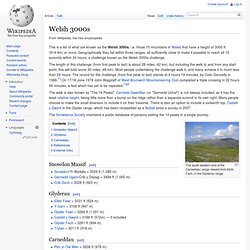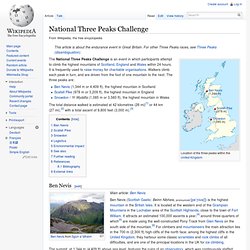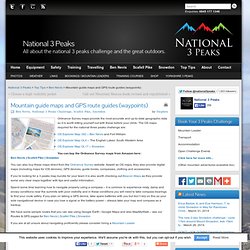

West Central Index Page on Undiscovered Scotland. Welsh 3000s. This is a list of what are known as the Welsh 3000s, i.e. those 15 mountains in Wales that have a height of 3000 ft (914.4m) or more.

Geographically they fall within three ranges, all sufficiently close to make it possible to reach all 15 summits within 24 hours, a challenge known as the Welsh 3000s challenge. The length of this challenge (from first peak to last) is about 26 miles (42 km), but including the walk to and from any start point, this will total some 30 miles (48 km). Most people undertaking the challenge walk it, and many achieve it in much less than 24 hours. The record for the challenge (from first peak to last) stands at 4 hours 19 minutes, by Colin Donnelly in 1988.[1] On 17/18 June 1978 John Wagstaff of West Bromwich Mountaineering Club completed a triple crossing in 22 hours 49 minutes, a feat which has yet to be repeated.[1][2] The Snowdonia Society maintains a public database of persons visiting the 14 peaks in a single journey.
Snowdon Massif[edit] Glyderau[edit] The Welsh 3000s Challenge / 14 Peaks / 15 Peaks. The 3000 feet mountains of Wales. The Welsh 3000s. Three Peaks Challenge. National Three Peaks Challenge. The National Three Peaks Challenge is an event in which participants attempt to climb the highest mountains of Scotland, England and Wales within 24 hours.

It is frequently used to raise money for charitable organisations. Walkers climb each peak in turn, and are driven from the foot of one mountain to the next. The three peaks are: Ben Nevis (1,344 m or 4,409 ft), the highest mountain in ScotlandScafell Pike (978 m or 3,209 ft), the highest mountain in EnglandSnowdon / Yr Wyddfa (1,085 m or 3,560 ft), the highest mountain in Wales The total distance walked is estimated at 42 kilometres (26 mi)[1] or 44 km (27 mi),[2] with a total ascent of 9,800 feet (3,000 m).[3] Ben Nevis[edit] The summit, at 1,344 m (4,409 ft) above sea level, features the ruins of an observatory, which was continuously staffed between 1883 and 1904.[7] The meteorological data collected during this period are still important for understanding Scottish mountain weather.
Scafell Pike[edit] Three Peaks Challenge Website - National 3 peaks challenge infromation. Mountain guide maps and GPS route guides (waypoints) Ordnance Survey maps provide the most accurate and up-to-date geographic data so it is worth kitting yourself out with these before your climb.

The OS maps required for the national three peaks challenge are: You can buy the Ordnance Survey maps from Amazon here:Ben Nevis | Scafell Pike | Snowdon You can also buy these maps direct from the Ordnance Survey website. Aswell as OS maps, they also provide digital maps (including maps for iOS devices), GPS devices, guide books, compasses, clothing and accessories. If you’re looking for a 3 peaks map bundle for your team it is also worth checking out Beacon Maps as they provide some very clear maps together with tips and useful information.
Spend some time learning how to navigate properly using a compass – it is common to experience misty, damp and snowy conditions near the summits with poor visibility and in these conditions you will need to take compass bearings to find your route safely. Team building and charity fundraising events for the national 3 peaks. Hadrian's Wall Country. Hadrians Wall, Famous areas to explore in Britain. Two thousand years of history, twenty-five roman forts and museums , 150 miles long – the border territories of Northumberland are steeped in history and intrigue.

When the Romans first occupied Britain in the middle of the first century, for much of the time until the beginning of the fifth century, Northumbria was the very edge of their mighty empire. Roman Ghosts. Hear the word 'ghosts' and it is not Roman ghosts that you think of, I would wager.

But that is exactly what these York ghosts are. They were clearly seen in February 1953 by an apprentice plumber called Harry Martingale as he worked in the cellars of the Treasurer's House. A procession of Roman soldiers, ghosts dating from the 4th century.Harry's account was as follows. He was standing on a ladder when he heard what he described as 'a tinny trumpet call'. At first, he thought that the sound must be coming from the road above him. On their knees! Two links of interestThe first is to an interview with Harry Martindale, the gentleman who saw the spectres. Return from Roman Ghosts to Famous Hauntings. Northern ghosts, legends, monsters and fortean activity - the paranormal database.